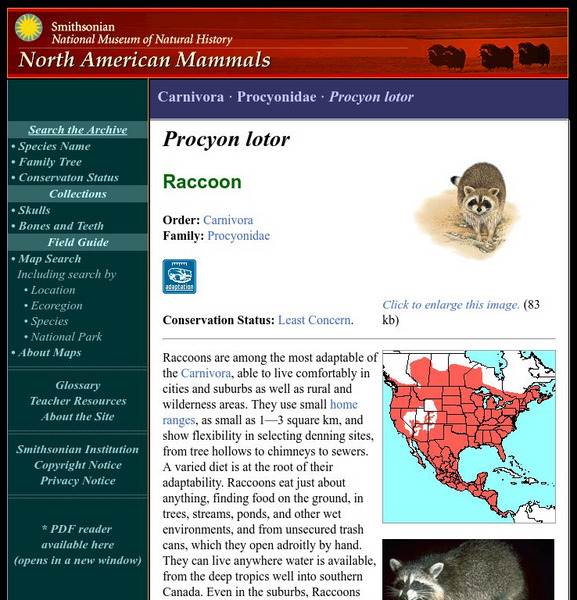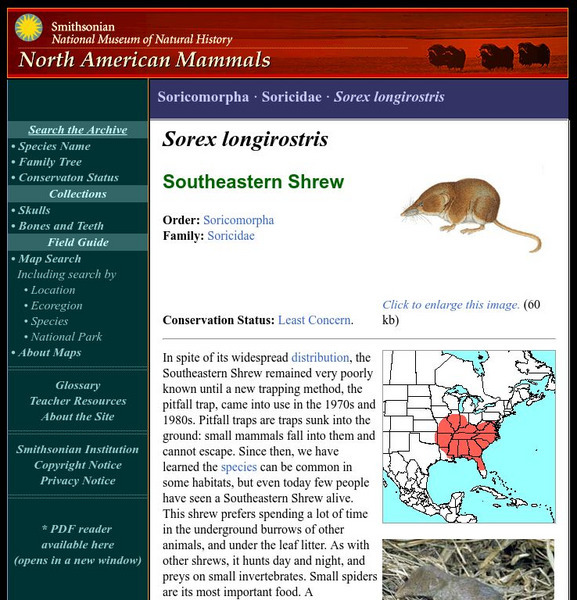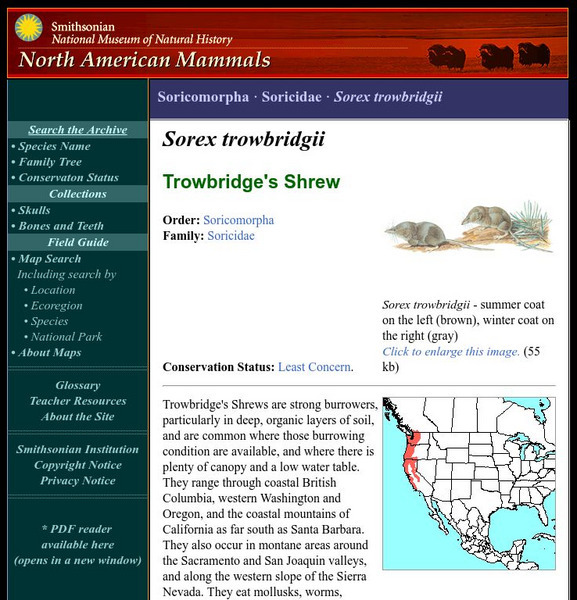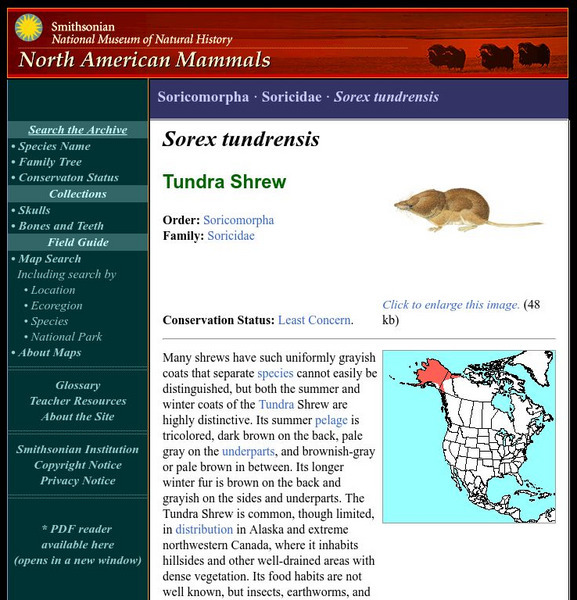Smithsonian Institution
National Museum of Natural History: American Mammals: White Nosed Coati
White-nosed Coatis are the most diurnal members of the family Procyonidae. They often sleep curled up in trees, and come down at dawn to forage, rooting with their long, mobile snouts and digging with long, curved claws for insects,...
Smithsonian Institution
National Museum of Natural History: American Mammals: Ringtail
Ringtails are nocturnal, cat-sized carnivores. They are good climbers and are found in habitats that range from dry canyons to wet woodlands, in highland and lowland terrain. Learn more about the Bassariscus astutus, more commonly known...
Smithsonian Institution
National Museum of Natural History: American Mammals: Mountain Goat
Mountain Goats live on remarkably steep, craggy cliffs for most of their lives, spending only about a quarter of their time in less forbidding meadows and nearby fields. The steep slopes offer safety from predators such as mountain lions...
Smithsonian Institution
National Museum of Natural History: American Mammals: Yellow Faced Pocket Gopher
The Yellow-faced Pocket Gopher feeds on starchy, tuberous roots of desert shrubs and on the roots and leaves of low-growing forbs. Like other pocket gophers, this species is considered an agricultural pest, doing extensive damage in...
Smithsonian Institution
National Museum of Natural History: American Mammals: Western Heather Vole
Western Heather Voles live in mountains, near or above the timberline. Where high-elevation forests have been clear-cut, they have been seen at lower elevations. Learn more about the Phenacomys intermedius, more commonly known as a...
Smithsonian Institution
National Museum of Natural History: American Mammals: Spotted Seal
Spotted Seals breed in isolated pairs rather than large groups. They congregate in breeding areas, but each pair keeps its distance. Learn more about the Phoca largha, more commonly known as a Spotted Seal, in this easy-to-read species...
Smithsonian Institution
National Museum of Natural History: American Mammals: Ringed Seal
Ringed Seals have dark gray or blackish coats with white or pale gray rings splotched across the back and sides. They are the smallest and most common earless seals of the icy northern seas. Learn more about the Phoca hispida, more...
Smithsonian Institution
National Museum of Natural History: American Mammals: Ribbon Seal
Ribbon Seals are rarely seen on land. In late winter and spring they are on pack ice, 100-200 km offshore, where they molt, mate, and pup. Learn more about the Phoca fasciata, more commonly known as a Ribbon Seal, in this easy-to-read...
Smithsonian Institution
National Museum of Natural History: American Mammals: Western Pipistrelle
Western pipistrelles sometimes leave their roosts before sundown and can be mistaken for late-flying butterflies, because they are so tiny and fly slowly and erratically, with much fluttering of their wings. Most common at low elevations...
Smithsonian Institution
National Museum of Natural History: American Mammals: Northern Raccoon
Raccoons are among the most adaptable of the Carnivora, able to live comfortably in cities and suburbs as well as rural and wilderness areas. They use small home ranges, as small as 1x3 square km, and show flexibility in selecting...
Smithsonian Institution
National Museum of Natural History: American Mammals: Marsh Shrew
Large for a shrew and with velvety dark fur, the Marsh Shrew can be found in marsh, stream, and beach habitats of the coastal rain forest in extreme southwestern Canada and the Pacific Northwest of the United States. This shrew is...
Smithsonian Institution
National Museum of Natural History: American Mammals: Southeastern Shrew
In spite of its widespread distribution, the Southeastern Shrew remained very poorly known until a new trapping method, the pitfall trap, came into use in the 1970s and 1980s. Pitfall traps are traps sunk into the ground: small mammals...
Smithsonian Institution
National Museum of Natural History: American Mammals: Water Shrew
Water Shrews are almost invariably found near streams or other bodies of water, where they find food and also escape from predators. These shrews readily dive to stream bottoms, paddling furiously to keep from bobbing to the surface,...
Smithsonian Institution
National Museum of Natural History: American Mammals: Pacific Shrew
An inhabitant of Oregon's moist streamsides, thickets, and woods, the Pacific Shrew does best in areas with brushy vegetation and fallen decaying logs. There it finds centipedes, slugs, and snails, insect larvae, amphibians, fungi, and...
Smithsonian Institution
National Museum of Natural History: American Mammals: Ornate Shrew
Since the Ornate Shrew is grayish-brown, with paler grayish underparts, and is small and inconspicuous overall, one may wonder about the inspiration for its name. Did it remind the biologist who named it, in 1895, of a well-dressed but...
Smithsonian Institution
National Museum of Natural History: American Mammals: Montane Shrew
Montane Shrews are among the most common shrews, and do well in a variety of moist habitats: thick, grassy areas near streams or rivers; meadows; thickets of willow and alder; spruce-fir forests; and alpine tundra. They are dietary...
Smithsonian Institution
National Museum of Natural History: American Mammals: Merriam's Shrew
Merriam's Shrew is noted for its predilection for dry habitats. It is most often found in sagebrush steppe, but also in grassland, brushland, and woodland, at elevations from 200 m to 2,900 m. Learn more about the Sorex merriami, more...
Smithsonian Institution
National Museum of Natural History: American Mammals: Mt. Lyell Shrew
The Mt. Lyell Shrew occurs only in the central Sierra Nevada Mountains of California and is found only at elevations above 2,000 m. Learn more about the Sorex lyelli, more commonly known as a Mt. Lyell Shrew, in this easy-to-read species...
Smithsonian Institution
National Museum of Natural History: American Mammals: Spiny Pocket Mouse
The Spiny Pocket Mouse is somewhat shaggy. Its spines, which are mostly on the rump, are not nearly as stiff as porcupine quills. Learn more about the Chaetodipus spinatus, more commonly known as a Spiny Pocket Mouse, in this...
Smithsonian Institution
National Museum of Natural History: American Mammals: Nelson's Pocket Mouse
Nelson's Pocket Mice live in the Chihuahuan Desert of north-central Mexico and adjacent parts of western Texas and southern New Mexico. They are found mostly in rocky areas where there are some shrubs to provide cover. Learn more about...
Smithsonian Institution
National Museum of Natural History: American Mammals: Pribilof Island Shrew
The Pribilof Island Shrew lives in maritime tundra on St. Paul Island, and almost nothing is known about its biology. Learn more about the Sorex pribilofensis, more commonly known as a Pribilof Island Shrew, in this easy-to-read species...
Smithsonian Institution
National Museum of Natural History: American Mammals: Trowbridge's Shrew
Trowbridge's Shrews are strong burrowers, particularly in deep, organic layers of soil, and are common where those burrowing condition are available, and where there is plenty of canopy and a low water table. They range through coastal...
Smithsonian Institution
National Museum of Natural History: American Mammals: Vagrant Shrew
Vagrant Shrews live in moist habitats throughout their range. They are common in lakeside or streamside communities of sedges, grasses, and willows, and in coastal salt marshes. Learn more about the Sorex vagrans, more commonly known as...
Smithsonian Institution
National Museum of Natural History: American Mammals: Tundra Shrew
Many shrews have such uniformly grayish coats that separate species cannot easily be distinguished, but both the summer and winter coats of the Tundra Shrew are highly distinctive. Its summer pelage is tricolored, dark brown on the back,...























